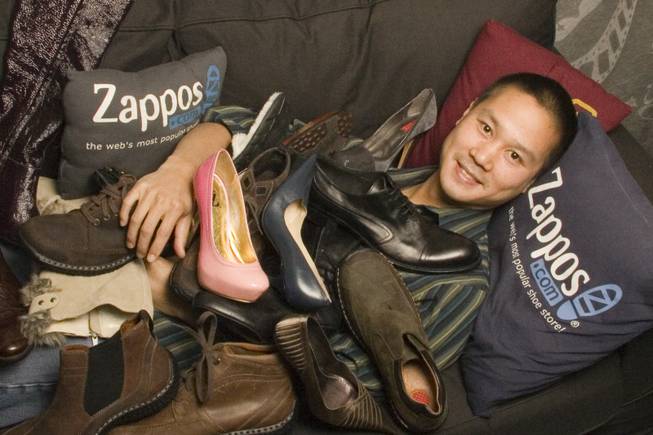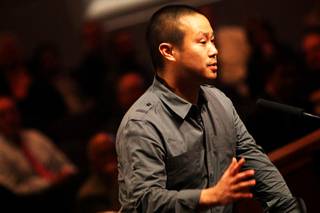
Courtesy photo
Zappos.com CEO Tony Hsieh poses with some of his company’s merchandise.
Thursday, March 17, 2011 | 2:01 a.m.
Sun archives
- Goodman: Zappos move a ‘watershed moment’ for downtown Las Vegas (12-1-2010)
- City of Henderson taking departure of Zappos.com in stride (12-1-2010)
- Zappos views Las Vegas City Hall as perfect fit for new headquarters (11-29-2010)
- Local, national Web retailers looking for Cyber Monday boost (11-29-2010)
- Henderson’s Zappos.com listed among best places to work (1-22-2010)
- From upstart to $1 billion behemoth, Zappos marks 10 years (6-16-2009)
- Henderson-based Zappos earns honors for ethics (4-13-2009)
On First Friday a few weeks ago, Eric Ryan, one of the executives behind Method biodegradable soap products sold at Target, was bar hopping on Fremont East with Tony Hsieh, CEO of Zappos.com.
The two walked past Palms owner George Maloof, Las Vegas Mayor Oscar Goodman and others. They stood at the east end of the block and gazed west, toward the Griffin, Beauty Bar and Vanguard taverns.
“I really like this,” said Ryan, the brand architect and co-founder of the $100 million-plus soap empire based in the San Francisco area.
It was the reaction Hsieh had hoped for. He hopes to hear it often as he talks to entrepreneurs, many of whom are friends from California’s Silicon Valley, about the potential of downtown Las Vegas.
Although Fremont East might gather admirers, he recognizes that isn’t enough. The area needs to grow and flourish to lure companies, which is Hsieh’s long-term goal.
For that to happen, he and his staff at Zappos are brainstorming ways to create a scene that will entice smart, culturally astute and fun-loving people to a place many would never have dreamed of calling home.
Hsieh’s marketing of Las Vegas, which began when he made the well-publicized decision to move his online shoe and clothing company from Henderson to downtown, has intensified.
“To get the kinds of people and businesses here to make it happen, you’re not going to do that with just the Strip,” Hsieh says. “If that’s all Vegas offers, they won’t come here.”
As Hsieh (pronounced “shay”) and his staff prepare to move his office and 1,000-plus employees into Las Vegas City Hall, which will be abandoned next year when the new city hall is complete, he is furiously acting as ambassador, cheerleader and brainstormer for the area.
Here is a smattering of ideas Hsieh rattles off in a few minutes. They would occur in tandem over the next five to 10 years, he said:
• A small airline of private jets to shuttle technology entrepreneurs from San Francisco to Las Vegas in about an hour. “The one-hour commute is about the same as going from San Francisco to Sunnyvale (a Silicon Valley high-tech hub). But what if your one-hour commute just happened to be by plane?”
• Hsieh and his staff are talking with the staff of Jamie Oliver, known on television as “The Naked Chef,” to create a community kitchen downtown to give free cooking classes. Oliver has started at least one community kitchen in Los Angeles.
• Explore establishing a K-12 charter school for creative learning in downtown Las Vegas.
• Zappos has more than a dozen staff working on Hsieh’s plan for a high-tech business incubator downtown. Friends who operate tech companies in Silicon Valley, including one who grew up in Las Vegas, are lending a hand. “They want to help in the same way I’d want to help someone set up something like this in San Francisco, where I grew up,” he said.
• Downtown homes for Zappos employees. The company is looking at either working out deals for cheaper rents with the mostly empty high-rise condo buildings downtown, or building a “Zappos dorm.”
• Hsieh is exploring building 500 to 1,000 units of 100-square-foot spaces rented for $100 a month — enough room for a bed and a closet, while bathroom facilities would be shared. Maybe a bar or lounge would be attached to the building and renters would crash there whenever they wanted. “Maybe call it the Crash Pad,” he said. Renters would be screened to keep it from becoming a homeless or hooker option, he said.
Hsieh is talking via phone from an Austin, Texas, airport where he’s about to board a plane after spending time at SXSW (South by Southwest), the megamusic, Internet and film festival.
He wants that in Las Vegas. He wants Austin. Here. Not just because he loves the scene, but because owners and employees of the companies he wants to move to Las Vegas would love it, too.
“You aren’t going to get those companies to move here or start something here without these elements in place,” Hsieh says.
To encourage a live-music scene, Hsieh explodes with ideas: Making deals with downtown hotels to house musicians who would fly into Vegas — with their flight and accommodations subsidized, maybe by Hsieh. Stay at the hotels and do maybe seven shows in seven bars in a week. “And if you fly in seven each week, you really start to create a scene, a buzz,” Hsieh said.
Penciled out on a napkin, he figured the subsidies would cost about $500,000 a year. “It’s not that expensive, and it’s basically to seed the music scene.” And after a few years, downtown Las Vegas may be so well-known for live music that bands will clamor to play here, diminishing the need for the subsidy.
“I don’t want it to take as long to develop as it took in Austin. We have to make it happen.”
Hsieh understands the next question, because he knows the history of Las Vegas well enough to know about the numerous operators who came to town, made big promises, then disappeared.
“Right now we are in the brainstorming phase,” Hsieh says. “We are excited about all the ideas but need to do a lot more research before we can determine what’s possible.”
He points to his donation of $2 million to the Smith Center for the Performing Arts, which made it through the legal hoops Monday, as proof that he is putting money into downtown. His company also rescued the city’s Corporate Challenge program by donating $132,000 to keep it alive.
“It’s something that brings the community together and would get our own employees involved,” he said.
“Vegas has a weird way of growing on you,” he says.
He says it because he is often asked why he wants to do so much here when he could take his company almost anywhere.
“It’s a part of me now,” he says. “I want to help create a place where I would want to hang out.”
He likens his vision for downtown Las Vegas to the moves Zappos underwent to create a rewarding and fun place to work.
“At Zappos, we’ve historically thought of our brand in terms of the ‘Three Cs’: clothing, customer service, and company culture,” he says. “Now we want to add a fourth C: community. We want to be a part of revitalizing downtown Las Vegas.”


Join the Discussion:
Check this out for a full explanation of our conversion to the LiveFyre commenting system and instructions on how to sign up for an account.
Full comments policy